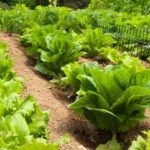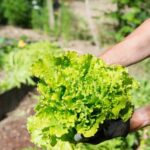Are treated landscape timbers safe for vegetable gardens? This is a common concern among gardeners who want to ensure the safety of their produce and the environment. Treated landscape timbers are often used in vegetable gardens to create raised beds and borders, but there are potential risks associated with these materials. It is important to understand what treated landscape timbers are and the implications of using them in your garden.
Treated landscape timbers are wooden boards that have been infused with preservative chemicals to prolong their lifespan and protect them from decay and pests. In a vegetable garden setting, it is crucial to prioritize the safety of the materials used, as they can directly impact the health of the plants and those consuming the produce. When considering the use of landscape timbers in a vegetable garden, it is essential to weigh the benefits against any potential risks.
The type of treatment used on landscape timbers can greatly affect their suitability for use in vegetable gardens. Pressure-treated timbers, which have been infused with chemical preservatives under high pressure, are commonly used but may pose risks due to leaching of chemicals into the soil. Additionally, it is important to explore alternative options such as timbers treated with non-toxic materials or other border materials altogether to ensure the safety and sustainability of your vegetable garden.
Types of Treated Landscape Timbers
Pressure-Treated Timbers
Pressure-treated landscape timbers are the most common type of treated wood used in outdoor construction, including garden beds. These timbers are infused with preservatives under high pressure to protect against decay and insect damage. The chemicals used in pressure-treated timbers have raised concerns about their safety when used in vegetable gardens.
Treated With Non-Toxic Materials
In response to these concerns, there are now landscape timbers available that are treated with non-toxic materials. These alternative treatments aim to provide the same level of protection against decay and pests without the potential risks associated with traditional pressure-treated timbers. When considering the use of treated landscape timbers in a vegetable garden, it is important to research and choose options that utilize non-toxic treatment methods.
Alternatives to Traditional Treated Timbers
For those who prefer to err on the side of caution or simply want to explore other options, there are alternatives to traditional treated landscape timbers. Cedar or redwood timbers are naturally resistant to decay and insect damage, making them a popular choice for organic gardening. Composite timbers made from recycled materials offer durability and low maintenance. Additionally, natural stone or brick borders can provide an attractive and long-lasting alternative to wood for garden bed borders.
When choosing treated landscape timbers for a vegetable garden, it is essential to consider the types available and the potential risks associated with their use. It is crucial for gardeners to prioritize the safety of their plants and those who will consume the produce grown within these garden beds.
By being informed about the types of treated landscape timbers as well as alternative options, gardeners can make well-informed decisions about what materials will best suit their needs while also prioritizing safety.
Potential Risks of Using Treated Landscape Timbers in Vegetable Gardens
Are Potential Risks
associated with using treated landscape timbers in vegetable gardens.
Leaching of Chemicals Into the Soil
One of the main concerns with using treated landscape timbers in vegetable gardens is the possibility of chemicals leaching from the wood into the soil. Pressure-treated timbers are often treated with chemicals such as chromated copper arsenate (CCA) or alkaline copper quat (ACQ), which can potentially seep into the surrounding soil over time.
Negative Impact on Plant Growth and Health
Chemicals leaching from treated landscape timbers can have a detrimental effect on plant growth and health. The presence of these chemicals in the soil can disrupt nutrient uptake by plants, leading to stunted growth, yellowing leaves, and other signs of distress.
Health Concerns for Those Consuming the Vegetables
In addition to impacting plant health, chemicals from treated landscape timbers can also pose health risks for those consuming the vegetables grown in contaminated soil. Consuming produce that has been grown in soil contaminated with chemical preservatives can introduce these harmful substances into the human body, potentially causing adverse health effects. Therefore, it is essential to carefully consider the potential risks before using treated landscape timbers in vegetable gardens.
Benefits of Using Treated Landscape Timbers in Vegetable Gardens
Using treated landscape timbers in vegetable gardens can offer several benefits, making them a popular choice for gardeners. Here are some of the advantages of using treated landscape timbers in vegetable gardens:
Benefits:
1. Longer lifespan of the timbers: Treated landscape timbers are more resistant to decay and pests, which means they have a longer lifespan compared to untreated timbers. This can save gardeners time and money in the long run, as they won’t need to replace the timbers as frequently.
2. Resistance to decay and pests: One of the main benefits of using treated landscape timbers is their ability to resist decay and deter pests. This can help maintain the structural integrity of raised beds and garden borders, ensuring that they remain stable and durable over time.
3. Cost-effectiveness: While treated landscape timbers may have a higher upfront cost compared to untreated options, their longer lifespan and resistance to decay and pests make them a cost-effective choice in the long term. Gardeners can save money on replacements and maintenance by using treated landscape timbers in their vegetable gardens.
It is important to note that despite these benefits, there are potential risks associated with using treated landscape timbers in vegetable gardens. It is crucial for gardeners to consider these risks and take necessary safety precautions when using treated landscape timbers in their gardens.
Safety Precautions for Using Treated Landscape Timbers in Vegetable Gardens
When considering using treated landscape timbers in a vegetable garden, it is important to take certain safety precautions to ensure the health of your plants and the safety of anyone consuming the produce. One of the main concerns when using treated timbers in a vegetable garden is the potential leaching of chemicals into the soil, which can have negative effects on plant growth and health.
Additionally, there are also health concerns for those consuming the vegetables grown in soil that has been exposed to treated timbers.
To mitigate these risks, there are several safety precautions that can be taken when using treated landscape timbers in a vegetable garden. Properly sealing the timbers before installation can help prevent chemical leaching into the soil. Choosing non-toxic treatment options for the timbers is another important step in ensuring the safety of your vegetable garden. It is also recommended to regularly test the soil and plants for any chemical contamination to catch any issues early on.
In addition to these precautions, it is important to stay informed about regulations and guidelines for using treated timber in vegetable gardens. The EPA has specific regulations on treated wood products, and organic gardening standards may also provide guidance on safe materials for vegetable gardens. Consulting with gardening experts and organizations can provide further recommendations for safe and sustainable garden materials.
| Safety Precaution | Explanation |
|---|---|
| Properly sealing | Helps prevent chemical leaching into the soil |
| Choosing non-toxic treatment options | Ensures the safety of your vegetable garden |
| Regularly testing soil and plants | To catch any chemical contamination early on. |
Alternatives to Treated Landscape Timbers
When considering the use of landscape timbers in vegetable gardens, it is important to explore alternatives to traditional treated timbers. Here are some options to consider:
- Cedar or redwood timbers: These natural wood options are naturally resistant to decay and pests, making them a great alternative to chemically treated timbers. However, they may come at a higher cost compared to traditional treated timbers.
- Composite timbers: Made from a combination of wood fibers and recycled plastic, composite timbers offer the look and feel of real wood without the need for chemical treatments. They are also highly durable and long-lasting.
- Natural stone or brick borders: For a completely non-toxic option, consider using natural stone or brick borders for your vegetable garden. Not only do they provide a beautiful aesthetic, but they are also environmentally friendly and safe for growing edible plants.
It is important to weigh the pros and cons of each alternative before making a decision for your vegetable garden. Consider factors such as cost, durability, and environmental impact when selecting the best option for your specific needs.
Ultimately, the goal is to choose materials that not only provide a suitable border for your vegetable garden but also promote the health and safety of the plants and those who will consume them. By exploring these alternatives to treated landscape timbers, gardeners can make informed choices that support sustainable and safe gardening practices.
Regulations and Guidelines for Using Treated Timbers in Vegetable Gardens
When considering landscape timbers for your vegetable garden, it is crucial to be aware of the regulations and guidelines surrounding their use. The main question that arises is: are treated landscape timbers safe for vegetable gardens? This is an important consideration because the materials used in your garden can have a direct impact on the health and safety of the plants grown there, as well as the individuals who consume them.
The Environmental Protection Agency (EPA) has strict regulations regarding treated wood products, including landscape timbers. It is essential to familiarize yourself with these regulations to ensure that any treated timbers used in your vegetable garden meet safety standards. Additionally, if you are following organic gardening practices, you must adhere to specific guidelines when selecting materials for your garden beds.
Many gardening experts and organizations also provide recommendations for using landscape timbers in vegetable gardens. These guidelines often emphasize the importance of choosing non-toxic treatment options and properly sealing the timbers to prevent chemical leaching into the soil. By following these expert recommendations, you can ensure that your vegetable garden is safe and sustainable for both the plants and those who will enjoy the harvested produce.
Overall, being mindful of regulations and guidelines when using treated landscape timbers in vegetable gardens is essential for creating a healthy and productive growing environment. By educating yourself on these standards and best practices, you can make informed decisions about the materials used in your garden beds, ultimately contributing to a safer and more sustainable gardening experience.
| Regulations | Organic Gardening Standards |
|---|---|
| EPA regulations on treated wood products | Adhering to specific guidelines when selecting materials for garden beds |
| Recommendations from gardening experts and organizations | Emphasizing non-toxic treatment options and proper timber sealing |
Conclusion
In conclusion, the question “Are Treated Landscape Timbers Safe for Vegetable Gardens?” is a complex issue with both potential risks and benefits to consider. Pressure-treated timbers offer a longer lifespan and resistance to decay and pests, making them a cost-effective choice for garden borders. However, the leaching of chemicals into the soil and the potential negative impact on plant growth and health raise valid concerns about using treated landscape timbers in vegetable gardens.
It is important for gardeners to take safety precautions when using treated landscape timbers in their vegetable gardens. Properly sealing the timbers, choosing non-toxic treatment options, and regularly testing the soil and plants for any chemical contamination can help minimize the risks associated with using treated timbers. Additionally, considering alternatives such as cedar or redwood timbers, composite timbers, or natural stone or brick borders can provide safe and sustainable options for garden materials.
Ultimately, while there are benefits to using treated landscape timbers in vegetable gardens, it is essential for gardeners to weigh these against the potential risks and make informed decisions about what materials to use in their gardens. By staying informed about regulations and guidelines for using treated timbers and considering organic gardening standards, gardeners can prioritize the safety of their vegetables and overall sustainability of their gardens. Overall, safety should be a top priority when choosing materials for vegetable gardens.
Frequently Asked Questions
Are Pressure Treated Landscape Timbers Safe for Vegetable Gardens?
Pressure treated landscape timbers are not considered safe for vegetable gardens because they are treated with chemicals such as arsenic, which can leach into the soil and contaminate the vegetables. This can pose risks to human health.
Can You Use Treated Timber for Vegetable Garden?
Using treated timber for a vegetable garden is not recommended due to the potential contamination of the soil and the vegetables. The chemicals used in treating the wood can be harmful if they leach into the garden over time, posing a risk to those consuming the produce.
Can Treated Wood Contaminated Vegetable Gardens?
Treated wood has the potential to contaminate vegetable gardens, especially when in direct contact with the soil. The chemicals used in treating the wood can leach into the soil, affecting the quality and safety of the vegetables grown in that space.

If you’re looking to get into vegetable gardening, or are just looking for some tips on how to make your current garden better, then you’ve come to the right place! My name is Ethel and I have been gardening for years. In this blog, I’m going to share with you some of my best tips on how to create a successful vegetable garden.





